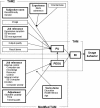User acceptance of HIV TIDES--Tailored Interventions for Management of Depressive Symptoms in persons living with HIV/AIDS
- PMID: 18096915
- PMCID: PMC2274800
- DOI: 10.1197/jamia.M2481
User acceptance of HIV TIDES--Tailored Interventions for Management of Depressive Symptoms in persons living with HIV/AIDS
Abstract
Objective: The Tailored Interventions for management of DEpressive Symptoms (TIDES) program was designed based on social cognitive theory to provide tailored, computer-based education on key elements and self-care strategies for depressive symptoms in persons living with HIV/AIDS (PLWHAs).
Design and measurement: Based on an extension of the Technology Acceptance Model (TAM), a cross-sectional design was used to assess the acceptance of the HIV TIDES prototype and explore the relationships among system acceptance factors proposed in the conceptual model.
Results: Thirty-two PLWHAs were recruited from HIV/AIDS clinics. The majority were African American (68.8%), male (65.6%), with high school or lower education (68.7%), and in their 40s (62.5%). PARTICIPANTS spent an average of 10.4 minutes (SD = 5.6) using HIV TIDES. The PLWHAs rated the system as easy to use (Mean = 9.61, SD = 0.76) and useful (Mean = 9.50, SD = 1.16). The high ratings of behavior intention to use (Mean = 9.47, SD = 1.24) suggest that HIV TIDES has the potential to be accepted and used by PLWHAs. Four factors were positively correlated with behavioral intention to use: perceived usefulness (r = 0.61), perceived ease of use (r = 0.61), internal control (r = 0.59), and external control (r = 0.46). Computer anxiety (r = -0.80), tailoring path (r = 0-.35) and depressive symptoms (r = -0.49) were negatively correlated with behavioral intention to use.
Conclusion: The results of this study provide evidence of the acceptability of HIV TIDES by PLWHAs. Individuals are expected to be empowered through participating in the interactive process to generate their self-care plan. HIV TIDES enables information sharing about depression prevention and health promotion and has the potential to reframe the traditional patient-provider relationship.
Figures
References
-
- Eysenbach G, Ryoung S, Diepgen T. Shopping around the internet today and tomorrow: towards the millennium of cybermedicine Br Med J 1999;319:1-5. - PubMed
-
- Krumholz HM, Rathore SS, Chen J, Wang Y, Radford MJ. Evaluation of a consumer-oriented internet health care report card: the risk of quality ratings based on mortality data JAMA 2002;287:1277-1287. - PubMed
-
- Turnin MC, Beddok RH, Clottes JP, Martini PF, Abadie RG, Buisson JC, et al. Telematic expert system Diabeto: new tool for diet self-monitoring for diabetic patients Diabetes Care 1992;15:204-212. - PubMed
Publication types
MeSH terms
Grants and funding
LinkOut - more resources
Full Text Sources
Medical



